
|
|
Font Size:
|
||||
|
|
|
|
||||
STATISTICAL BRIEF #484:
Expenses for Office-Based Physician Visits by Specialty, 2013
Highlights
- While the overall mean expense for an office-based physician visit in 2013 was $228, mean expenses per visit ranged across specialty types from $143 to $310.
- Median expenses per visit ($108 overall) were substantially lower and varied less dramatically by physician specialty than mean expenses.
- In 2013, out-of-pocket payments were made for slightly less than half of all office-based physician visits. However, this proportion varied across specialty types from approximately 39 percent to 61 percent.
- The overall mean out-of-pocket payment for an office-based visit was $29, but ranged across specialty types from $14 to $48.
Introduction
The extent to which the U.S. population uses primary care physicians relative to other types of physician specialists has important policy-relevant implications for both the cost and quality of health care. Using the Household Component of the Medical Expenditure Panel Survey (MEPS-HC), this Statistical Brief provides descriptive statistics for the U.S. civilian noninstitutionalized population illustrating variation in average total and out-of-pocket expenses per visit across selected office-based physician specialty types in 2013. Specifically, data are shown for the eight most frequently seen physician specialists in an office-based setting, including: 1) primary care physicians in general practice, family practice, or internal medicine (34.4 percent of visits); 2) pediatrics (8.2 percent); 3) obstetrics/gynecology (6.5 percent); 4) ophthalmology (6.7 percent); 5) orthopedics (5.6 percent); 6) psychiatry (4.7 percent); 7) cardiology (3.8 percent); and 8) dermatology (3.2 percent); as well as a ninth catchall category that includes all other physician specialty types (26.8 percent). When discussing means, only estimates for specialty categories that differ significantly from the national average for all office physician visits at the .05 level are noted.Findings
Total expenses (figures 1–3)The overall national average expense for an office-based physician visit in 2013 was $228 (figure 1). However, means per visit varied substantially by physician specialty. For example, the means for primary care providers (general practitioners, family practitioners, and internists), pediatricians, and psychiatrists of $166, $161, and $143, respectively, were below the national average of $228. Conversely, means for visits to ophthalmologists ($253), orthopedists ($302), cardiologists ($303), and physicians in the "all other" category ($310) exceeded the overall mean.
Mean expenses were notably higher than medians for all physician office visits and for each specialty category, which is attributable to relatively small proportions of very expensive visits pulling up the mean. Overall, the median expense for an office-based visit to a physician in 2013 was $108 (figure 2) which was less than half the overall mean expense per physician visit of $228. Moreover, median expenses ranged less dramatically across specialty types (from $100 to $124) than did mean expenses ($143 to $310).
Interquartile ranges (IQRs) of payments per visit are shown in figure 3. IQRs reflect the amounts paid for visits between the 25th and 75th percentiles (i.e., one-quarter of visits had total payments less than the 25th percentile and one-quarter had payments greater than the 75th percentile) and illustrate greater variability in payments per visit for some specialties than others. For example, the IQRs were $69–$157 for primary care and $66–$157 for psychiatry. These ranges were somewhat smaller than those for orthopedics ($70–$209), OB/GYN ($56–$200), and dermatology ($73–$220).
Out-of-pocket payments (figures 4 and 5)
In 2013, slightly less than half (48.0 percent) of all office-based physician visits had some out-of-pocket payments made toward the bill (figure 4). However, out-of-pocket payments were made for larger proportions of visits to primary care physicians (52.0 percent), ophthalmologists (52.3 percent), and dermatologists (60.7 percent). Conversely, smaller proportions of visits to pediatricians (38.9 percent), obstetricians/gynecologists (40.5 percent), cardiologists (40.8 percent), and "all other" specialty groups (45.9 percent) had out-of-pocket expenses.
The overall mean out-of-pocket expense for an office-based physician visit in 2013 was $29 but among visits with some out-of-pocket payments was $61 (figure 5). Mean out-of-pocket expenses per visit varied somewhat by physician specialty. For example, the means for primary care providers and pediatricians were below the national average while means for visits to ophthalmologists and physicians in the "all other" category exceeded the national average.
Data Source
The estimates in this Statistical Brief are based upon data from the MEPS 2013 Office-Based Medical Provider Visits Files (HC-160G).Definitions
Expenses/expendituresPayments from all sources for office-based physician visits reported by respondents in the MEPS-HC. Sources include direct payments from individuals, private insurance, Medicare, Medicaid, Workers' Compensation, and miscellaneous other sources.
Type of specialist
MEPS respondents who reported an office-based visit in which a medical doctor was seen were asked to identify the doctor's specialty (the questionnaire contains 34 response categories for coding the specialty type reported). A small proportion of sample physician visit events in which a medical doctor was seen (1.9 percent) were excluded from the analysis because specialty type was not reported. In this Statistical Brief, the categories for general practice, family practice, and internal medicine (internist) were combined because it may be difficult for respondents to distinguish between these types of primary care physicians (pediatricians were kept as a separate category). Multiple types of physician specialties were combined into the catchall "all other" category shown in this Brief, including allergy/immunology, anesthesiology, endocrinology/metabolism, gastroenterology, general surgery, geriatrics, hematology, hospital residence, nephrology, nuclear medicine, oncology, osteopathy, otorhinolaryngology (ear, nose, throat), pathology, physical medicine/rehab, plastic surgery, proctology, pulmonary, radiology, rheumatology, thoracic surgery, urology, and other doctor specialty. Though each of the specialist types within the "all other" category comprised only a small proportion of all physician visits, they cumulatively comprised approximately one-quarter of all visits.
About MEPS-HC
MEPS-HC is a nationally representative longitudinal survey that collects detailed information on health care utilization and expenditures, health insurance, and health status, as well as a wide variety of social, demographic, and economic characteristics for the U.S. civilian noninstitutionalized population. It is cosponsored by the Agency for Healthcare Research and Quality and the National Center for Health Statistics.For more information about MEPS, call the MEPS information coordinator at AHRQ (301-427-1656) or visit the MEPS Web site at http://www.meps.ahrq.gov/.
References
For a detailed description of the MEPS survey design, sample design, and methods used to minimize sources of nonsampling error, see the following publications:Cohen, J. Design and Methods of the Medical Expenditure Panel Survey Household Component. MEPS Methodology Report No. 1. AHCPR Pub. No. 97-0026. Rockville, MD: Agency for Health Care Policy and Research, 1997. http://meps.ahrq.gov/mepsweb/data_files/publications/mr1/mr1.shtml.
Cohen, S. Sample Design of the 1996 Medical Expenditure Panel Survey Household Component. MEPS Methodology Report No. 2. AHCPR Pub. No. 97-0027. Rockville, MD: Agency for Health Care Policy and Research, 1997. http://meps.ahrq.gov/mepsweb/data_files/publications/mr2/mr2.shtml.
Cohen, S. Design Strategies and Innovations in the Medical Expenditure Panel Survey. Medical Care, July 2003: 41(7) Supplement: III-5-III-12.
Suggested Citation
Machlin, S.R. and Adams, S.A. Expenses for Office-Based Physician Visits by Specialty, 2013. Statistical Brief #484. November 2015. Agency for Healthcare Research and Quality, Rockville, MD. http://meps.ahrq.gov/mepsweb/data_files/publications/st484/stat484.shtml.AHRQ welcomes questions and comments from readers of this publication who are interested in obtaining more information about access, cost, use, financing, and quality of health care in the United States. We also invite you to tell us how you are using this Statistical Brief and other MEPS data and tools and to share suggestions on how MEPS products might be enhanced to further meet your needs. Please email us at MEPSProjectDirector@ahrq.hhs.gov or send a letter to the address below:
Joel W. Cohen, PhD, Director
Center for Financing, Access, and Cost Trends
Agency for Healthcare Research and Quality
5600 Fishers Lane
Rockville, MD 20857
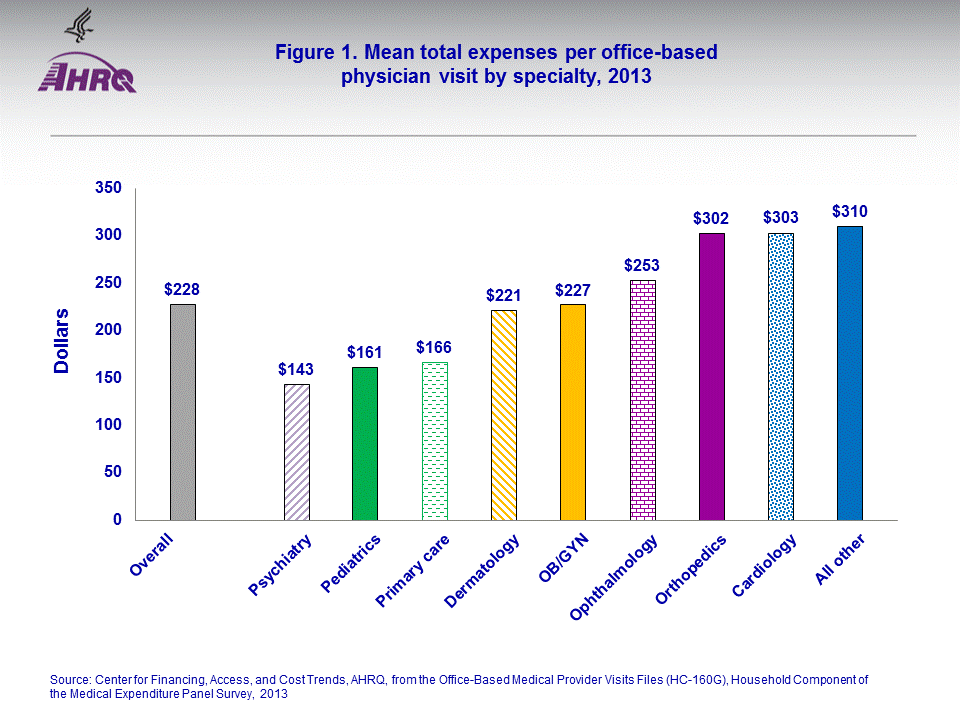
| Overall and by specialty | Mean total expense |
|---|---|
| Overall | $228 |
| Psychiatry | $143 |
| Pediatrics | $161 |
| Primary care | $166 |
| Dermatology | $221 |
| OB/GYN | $227 |
| Ophthalmology | $253 |
| Orthopedics | $302 |
| Cardiology | $303 |
| All other | $310 |
Source: Center for Financing, Access, and Cost Trends, AHRQ, from the Office-Based Medical Provider Visits Files (HC-160G), Household Component of the Medical Expenditure Panel Survey, 2013
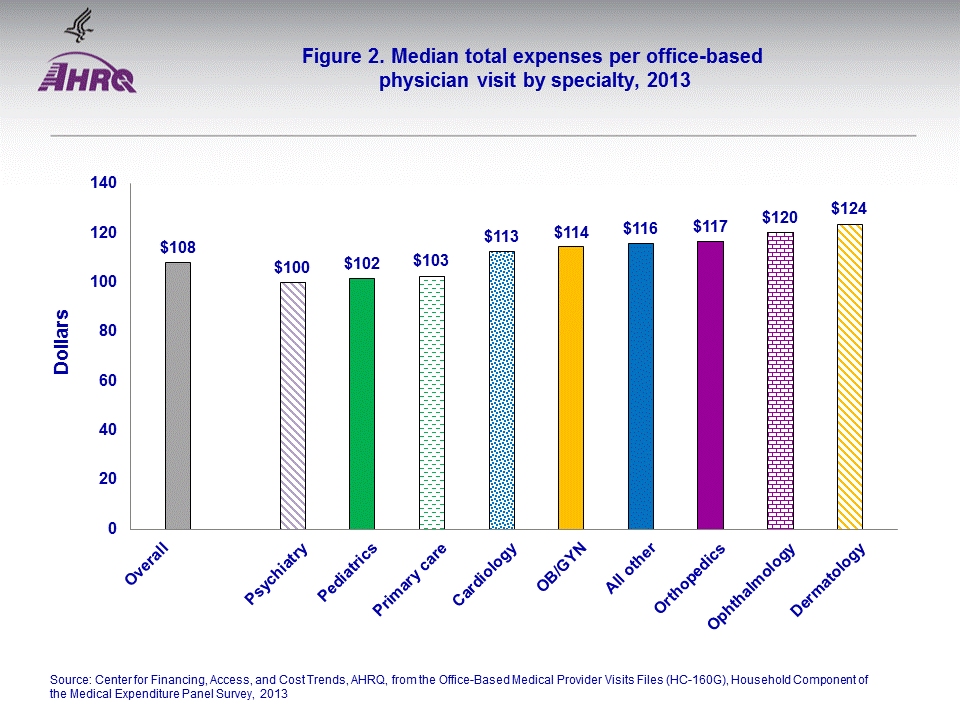
| Overall and by specialty | Median total expense |
|---|---|
| Overall | $108 |
| Psychiatry | $100 |
| Pediatrics | $102 |
| Primary care | $103 |
| Cardiology | $113 |
| OB/GYN | $114 |
| All other | $116 |
| Orthopedics | $117 |
| Ophthalmology | $120 |
| Dermatology | $124 |
Source: Center for Financing, Access, and Cost Trends, AHRQ, from the Office-Based Medical Provider Visits Files (HC-160G), Household Component of the Medical Expenditure Panel Survey, 2013
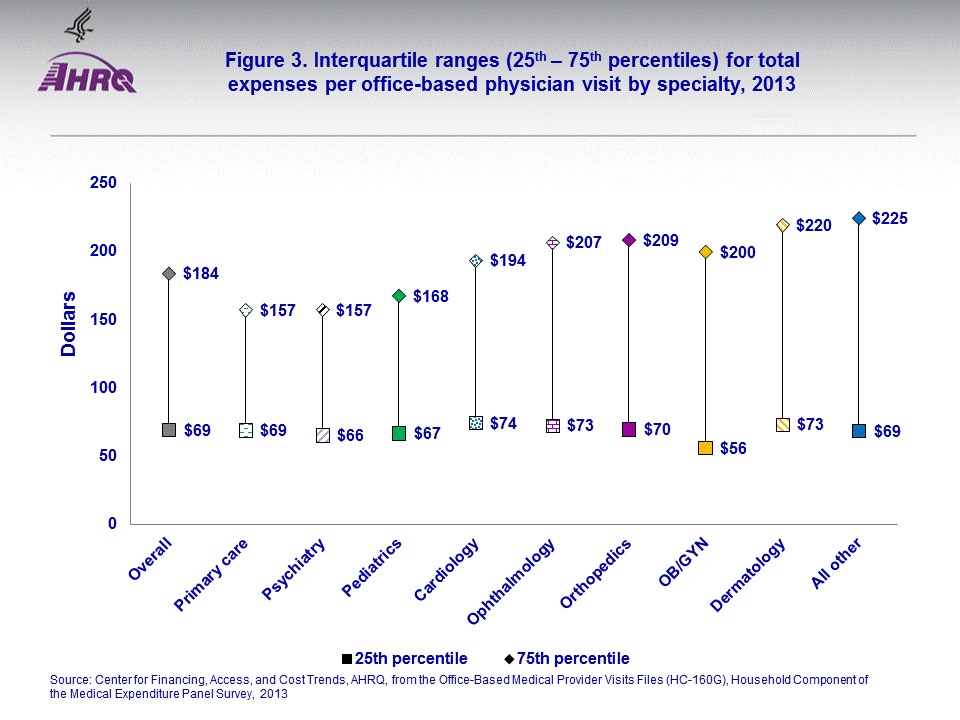
| Overall and by specialty | 25th percentile | 75th percentile |
|---|---|---|
| Overall | $69 | $184 |
| Primary care | $69 | $157 |
| Psychiatry | $66 | $157 |
| Pediatrics | $67 | $168 |
| Cardiology | $74 | $194 |
| Ophthalmology | $73 | $207 |
| Orthopedics | $70 | $209 |
| OB/GYN | $56 | $200 |
| Dermatology | $73 | $220 |
| All other | $69 | $225 |
Source: Center for Financing, Access, and Cost Trends, AHRQ, from the Office-Based Medical Provider Visits Files (HC-160G), Household Component of the Medical Expenditure Panel Survey, 2013
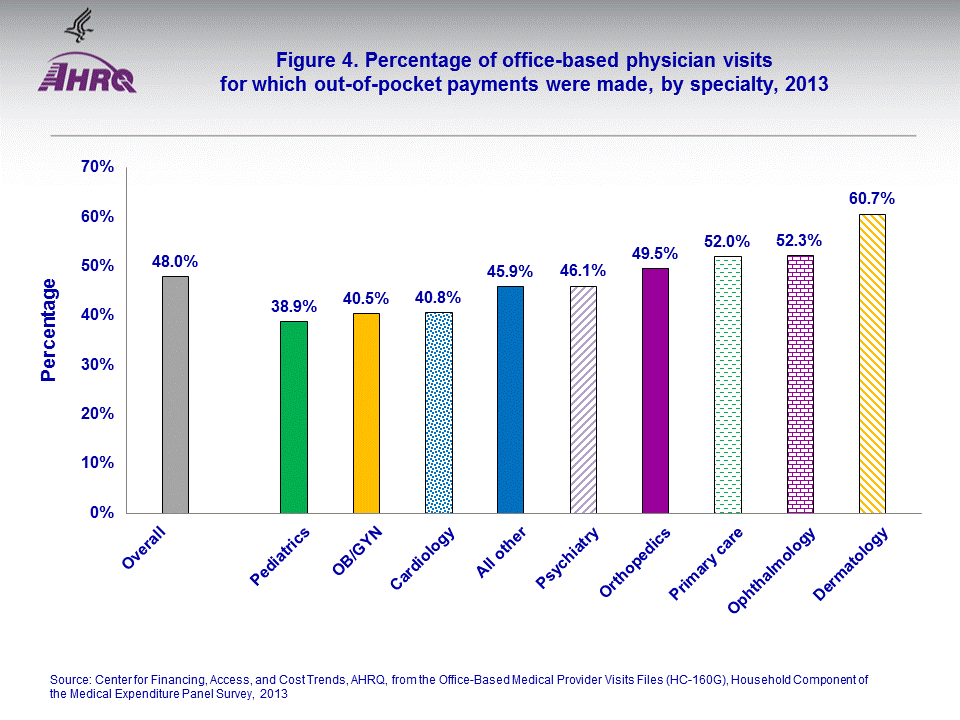
| Overall and by specialty | Percentage |
|---|---|
| Overall | 48.0% |
| Pediatrics | 38.9% |
| OB/GYN | 40.5% |
| Cardiology | 40.8% |
| All other | 45.9% |
| Psychiatry | 46.1% |
| Orthopedics | 49.5% |
| Primary care | 52.0% |
| Ophthalmology | 52.3% |
| Dermatology | 60.7% |
Source: Center for Financing, Access, and Cost Trends, AHRQ, from the Office-Based Medical Provider Visits Files (HC-160G), Household Component of the Medical Expenditure Panel Survey, 2013
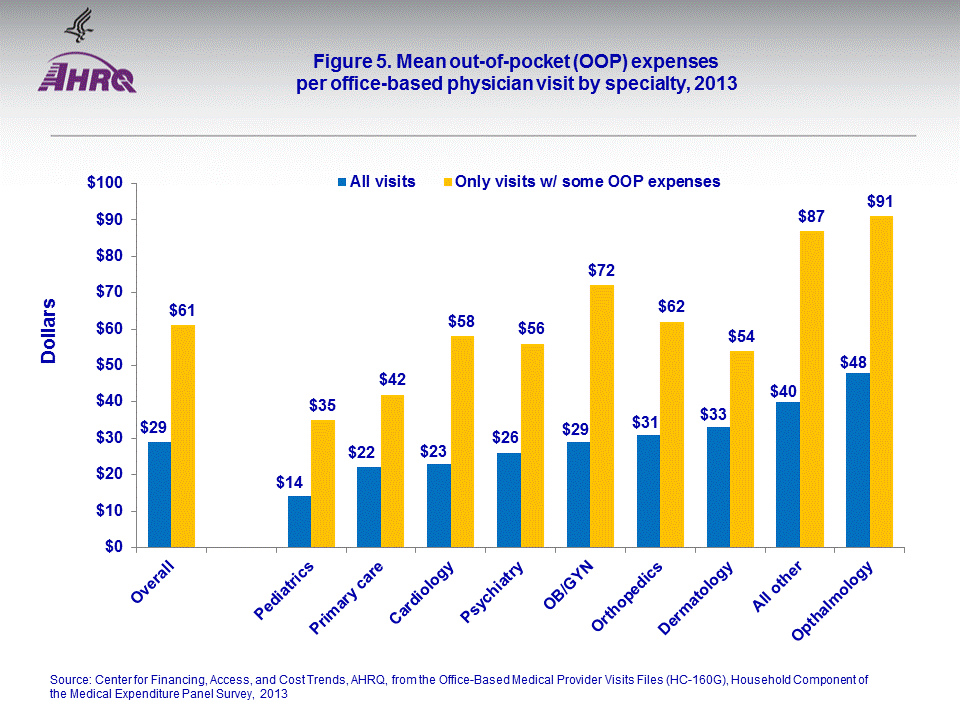
| Overall and by specialty | All visits | Only visits with some OOP expenses |
|---|---|---|
| Overall | $29 | $61 |
| Pediatrics | $14 | $35 |
| Primary care | $22 | $42 |
| Cardiology | $23 | $58 |
| Psychiatry | $26 | $56 |
| OB/GYN | $29 | $72 |
| Orthopedics | $31 | $62 |
| Dermatology | $33 | $54 |
| All other | $40 | $87 |
| Ophthalmology | $48 | $91 |
Source: Center for Financing, Access, and Cost Trends, AHRQ, from the Office-Based Medical Provider Visits Files (HC-160G), Household Component of the Medical Expenditure Panel Survey, 2013


